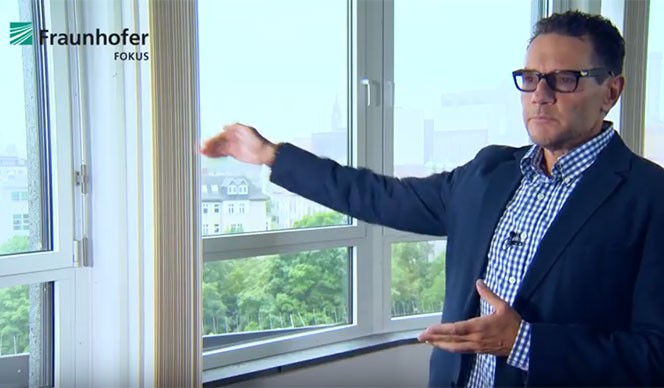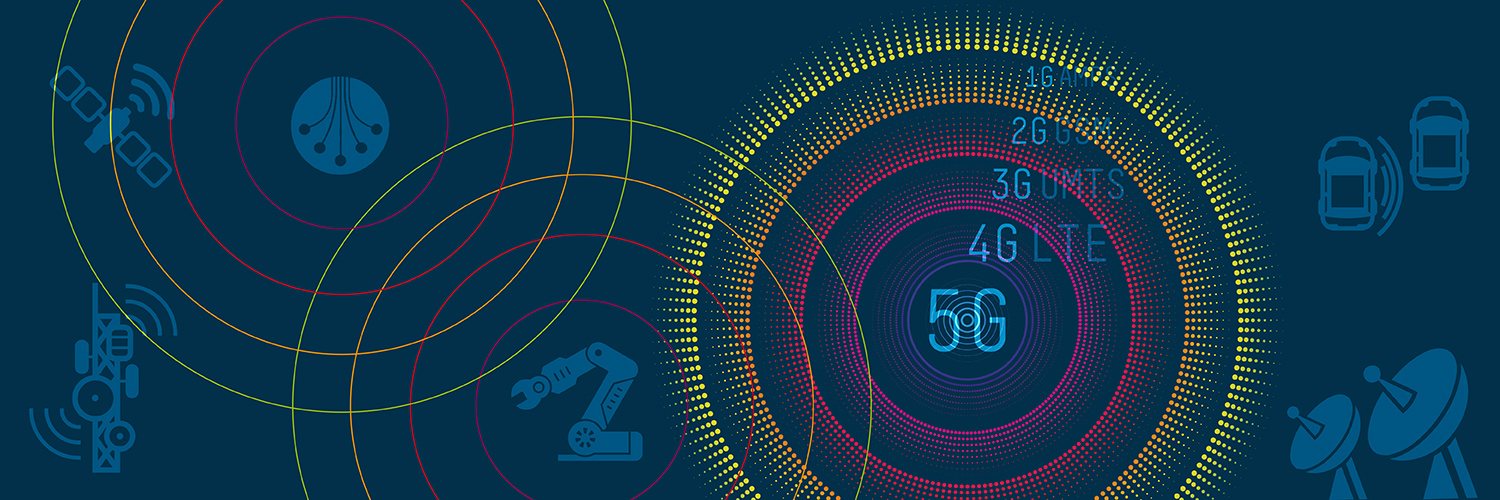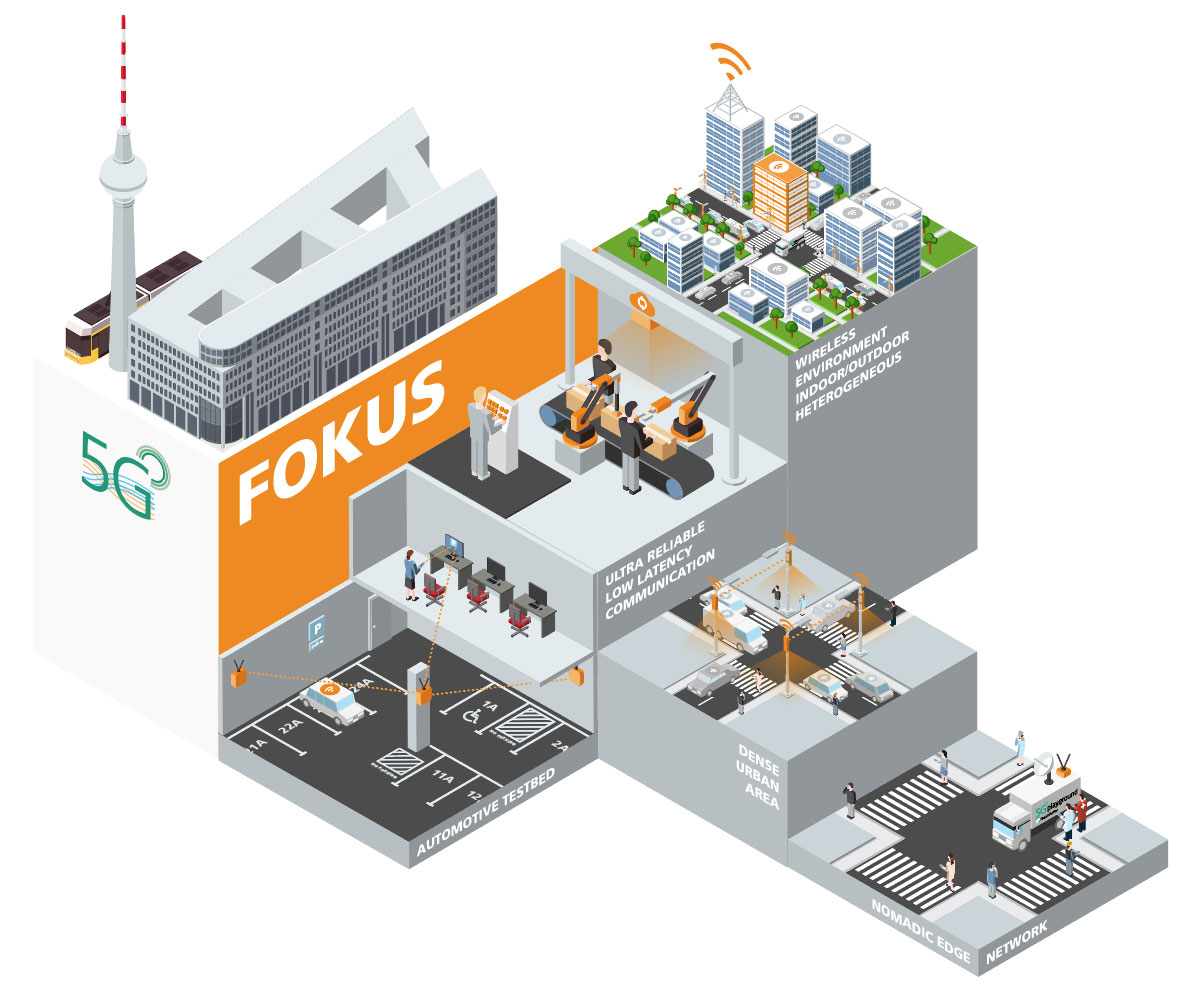While 5G is the successor to 4G (LTE), the fifth generation is a great deal more than just a new mobile communications standard. The extremely powerful mobile communications technology is what makes the promises of Industrie 4.0 and autonomous driving possible, and Fraunhofer is playing a decisive part in developing 5G technologies. The researchers know exactly what the potential of 5G is – and the hurdles that need to be overcome.
5G – The future in the network
5G activities of the Fraunhofer-Gesellschaft
The manufacturing of aircraft engines represents one of the huge challenges in industrial manufacturing. High standards of security and quality apply here. The manufacturing of the blisks (Blade Integrated Discs) alone can cost up to €80,000 in serial production. One of the problems here is the natural oscillation of the components while they are undergoing machine processing. If the blades are excited in their natural frequency, their surface quality is no longer guaranteed and the component has to be finished by hand, which is time intensive and expensive.
At the Fraunhofer Institute for Production Technology IPT in Aachen, the problem has now been successfully solved with the aid of 5G technology. A sensor monitors the blisks’ vibration spectrum during processing and activates a certain amplitude alarm if thresholds are exceeded. The respective data are transmitted wirelessly per 5G from the machine and processed further externally. Control impulses can therefore be transmitted to the machines that prevent natural oscillations. The completed manufacturing process results in a perfect component that does not require any reworking at all.
This 5G technology application was developed by IPT together with Swedish mobile communications infrastructure provider Ericsson in the “High-Performance Center Networked, Adaptive Production”. It is only one of many applications that will be enabled by 5G in the future.
- Fraunhofer IPT (ipt.fraunhofer.de)
- High-Performance Center Networked, Adaptive Production
Prof. Dr. Thomas Magedanz, #Berlin5GWeek, November 2017

Privacy warning
With the click on the play button an external video from www.youtube.com is loaded and started. Your data is possible transferred and stored to third party. Do not start the video if you disagree. Find more about the youtube privacy statement under the following link: https://policies.google.com/privacy5G is considered a future technology par excellence. Along with Fraunhofer IPT and Fraunhofer FOKUS, the Fraunhofer Institute for Integrated Circuits IIS and the Fraunhofer Institute for Telecommunications, Heinrich-Hertz-Institute HHI, are active here, having set three focus areas:
- development of new technologies and technical components
- cooperation in international standardization committees
- testing of practical implementations in real-world environments.
The contributions of Fraunhofer experts are now all the more important, as Fraunhofer has worked together with various vertical industries for years in a strong network and is familiar with their requirements, as well as the capabilities and limits of current wireless solutions.
The demands made on 5G are high. They include, for instance, an end-to-end transmission latency of a few milliseconds and transmission speeds of more than ten Gigabit per second (Gbit/s). These goals can only be achieved through changing many components of communication transmission. Depending on the application, the requirements can be already fully supported with early versions of the 5G standard or only at a later date with subsequent versions. Up until now, the feasibility of highest data rates or latencies of around one millisecond have already been realized as prototypes. It will be some time, however, until this has become part of everyday mobile networks.
Thomas Magedanz points out that the performance requirements depend to a great extent on the application. “With the streaming of videos, for example, having a high bandwidth used to rapidly transfer large volumes of data is the main issue. Latency plays less of a role here.”
Application clusters for 5G
This becomes evident if one takes a look at the three largest areas in which 5G will play a role in the future:
- Enhanced Mobile Broadband (eMBB)
- Massive Internet of Things (MIoT) beziehungsweise Massive Machine-type Communication (mMTC)
- Mission Critical IoT (Ultra-Reliable LowLatency Communications – URLLC).
In the case of enhanced mobile broadband, it depends on the throughput, meaning the volume of data that can be transmitted per unit of time. This is important with video streaming for instance. With the Massive Internet of Things, what is important is that data are transferred by millions of devices using the wireless network. In environmental protection and farming, sensors measure the water quality of rivers, for example, along with plant growth and air pollution. The main challenge is posed by having the maximum number of sensors possible communicating wirelessly with the network with the greatest energy efficient transmission technology possible.
In the case of Mission Critical Communication application scenarios – take industrial manufacturing and networked mobility for example – reliability and latency periods are decisive. With Industrie 4.0, machines, components and control software need to communicate with each other. Only then can the control software respond immediately to problems, enabling production lines to reorganize themselves in the event of failure.
The criteria of latency and reliability are decisive in the area of autonomous driving as well. Here a quick wireless network allows vehicles on the road to communicate with each other and the infrastructure. Vehicles can therefore drive one behind the other in convoys while receiving current information on the route or on traffic jams and accident reports.
Why 5G is so fast
How does 5G achieve this powerful output? Fraunhofer researchers are working on a series of forward-looking concepts. One example is multi-antennae systems, so-called MIMO (Multiple Input Multiple Output), that ensure a more robust transmission with an accelerated data rate. If the number of antennae elements is increased, the energy emitted can be directly sent to the recipient and does not have to be distributed across the surface, as before.
The innovative Massive MIMO technology delivers increased coverage and energy-efficient targeted transmission. Particularly with high frequencies in the millimeter wave range, with 28 Gigahertz (GHz) for instance, these antennas enable compact construction and a high level of concentration gains.
A prerequisite for the high data transmission rates is the expansion of the frequency spectrum. While the former mobile 4G (LTE) is used in a range of between 700 Megahertz MHz and 2.7 GHz, the spectrum within which 5G is operated is significantly wider. “The spectrum for 5G will be extended to 6 GHz in frequency range 1. Added to this is another 5G spectrum in the millimeter wave band that achieves up to 52 GHz in frequency range 2. This is a spectrum that is ten times as wide,” Dr. Haustein explains. Other tricks that researchers use to enhance the reliability of data transmission, for instance, can be summarized under the keyword of redundancy. In this instance, identical data packets are sent simultaneously via several base stations in various directions to ensure that they reach the recipient.
Testing in a real-world environment
The Fraunhofer experts are not stopping at theories about antennae and frequencies, however. They are working on developing various system components and testing them with industrial partners. They operate test facilities and demonstrators. An over-the-air (OTA) test facility of Fraunhofer IIS in Ilmenau, for example, allows antennas and devices to be tested.
Fraunhofer IIS’s L.I.N.K. building in Nuremberg enables new technologies for communication and positioning to be tried out. Here test facilities are used to investigate positioning technologies important for autonomous driving and indoor navigation without GPS satellite coverage. End-to-end 5G applications for IoT, autonomous driving, industrial communications and enhanced mobile broadband can be experimented with in test fields in Erlangen and Nuremberg as well as in the test fields in Berlin. Among other things, this includes wireless transmission technologies and reconfigurable network architectures, along with a core network that enables different applications such as Massive IoT or URLLC to be operated in parallel without these applications interfering with each other.
5G Bavaria Industrie 4.0 Test Bed
At Fraunhofer IPT in Aachen, a 5G NR system is being used in a building with machines and robots so that 5G can be tested under real production conditions.
Tracking and navigation
Satellites play an important role in the development of 5G. With 5G, satellite communication and terrestrial mobile communication merge together seamlessly. In defining the 5G standard, account is taken of the technical peculiarities of the satellite. A special role will be played by LEO (Low Earth Orbit) satellites in particular. These satellites orbit the earth at a relatively low distance of between 500 and 2,000 kilometers. LEOs are necessary for IoT applications, for instance, with thousands of sensors from monitoring stations sending data. Applications are feasible here particularly in environmental protection and farming. Today farming machinery has already harnessed the GPS technology to keep harvesting and mowing machinery exactly in the furrows through determining their position.
GPS and 5G ideally supplement each other here. Particularly where GPS reaches its limits, such as in inner-city areas or in buildings, a high density of 5G nodes can be expected in the future. The dense network enables extremely precise tracking. With this in mind, IIS scientists are developing suitable algorithms and tracking procedures.
Fraunhofer Cluster of Excellence »Cognitive Internet Technologies CCIT«
5G is predestined for cognitive Internet as well. The Fraunhofer Cluster of Excellence “Cognitive Internet Technologies CCIT” combines the competences of 13 Fraunhofer Institutes in the fields of cognitive, secure sensor technology, data sovereignty and machine learning. Intelligent merchandise tracking with secure cognitive sensors is an example of an application developed in CCIT. 5G supports the communication and the exchange of bulk data so that the agents within a product chain receive all the necessary information in real time.
- www.cit.fraunhofer.de (cit.fraunhofer.de)
Cloud concepts and edge computing
Data packages sent via 5G not only have to be transferred rapidly but also processed quickly, which requires computing capacity, storage and intelligent algorithms. The researchers therefore extend 5G systems with cloud concepts
In the future Smart Factory, sensors, components, robots and/or machines can send data to be processed in the Cloud. The swift and intelligent analysis of data can take place here and the entire facility can be controlled here by the control software. If a company sets up its own local cloud and the server are located on the premises, very low latency times can be realized. “One of the advantages is that computing capacities are easily scalable in the Cloud,” explains Niels König, head of the Production Metrology Department at Fraunhofer IPT.
Edge computing also contributes to accelerating data traffic. With edge computing, data are already processed at innovative base stations or special gateways and data centers on the edge of the network. .
Software developers at FOKUS
Experts working at Fraunhofer FOKUS in Berlin have defined another focus: They are developing special software tools for configuring 5G testbeds. As obvious as it may seem that mobile networks do not function without intelligence software, so the astonishing is the degree to which software-controlled network virtualization can expand the possibilities. Networks like these make it possible for all functions to be realized through software components that can be made to fit together just like Lego bricks dynamically in central or local data centers in accordance with requirements.
And the hour of network slicing has also come. Various virtual networks are installed and operated on the computer centers. While one slice runs on enhanced mobile broadband, for example, and makes a high broadband available to the users of a video streaming service, the time-critical application of a mid-sized automobile supplier that relies on low latency times and absolute reliability for robot control might be running in the neighboring slice.
Companies seeking to develop a customized 5G network for their solution or their business model benefit above all from the new possibilities. As the most important 5G software components will be available by 2020, individual deployments may be ready much earlier. Network slicing is already being tested today with industrial partners in the Berlin 5G playground for industrial IoT applications using programmable edge computing nodes.
Reserved broadbands
Individual solutions could function even better if companies did not have to depend on mobile service providers but could build up their own wireless networks on company premises. The German Federal Network Agency plans to make part of the frequency spectrum between 3.7 and 3.8 GHz available to companies or regional providers as a reserved broadband. Fraunhofer expert Niels König thinks the idea is very promising: “Companies would not have to depend on a mobile service operator and could take care of their data security themselves.”
Defining standards
Companies are waiting for binding standards applicable to the concrete implementation of 5G plans. Only once these standards are available can ready-made solutions and devices be launched on the market. The international 3rd Generation Partnership Project (3GPP) committee, a collaboration between groups of telecommunications standards associations, is responsible for mobile communications. The specifications are currently being defined in monthly working meetings with the participation of experts from all over the world. The first version of the standard (Release 15) has just been approved. The Fraunhofer Institutes HHI and IIS are actively participating in working on technical specifications for the 5G standard, with support from the Fraunhofer FOKUS starting this year in the domain of special networks and network slicing. The first 5G devices are anticipated as early as 2020.
Due to the necessary investment and the complexity of the mobile networks, it will be a few years before 5G networks with all their functions are available across the board. At the latest by this point, features such as latency times of a millisecond, broadbands of ten GB per second and absolute reliability will become part of everyday life in companies, in transport and in the smart city. .

